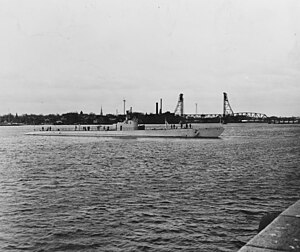USS Cachalot (SS-170)
 USS Cachalot SS-170
| |
| History | |
|---|---|
| Name | USS Cachalot |
| Namesake | sperm whale |
| Builder | Portsmouth Naval Shipyard, Seavey's Island, Kittery, Maine[1] |
| Laid down | 21 October 1931[1] |
| Launched | 19 October 1933[1] |
| Commissioned | 1 December 1933[1] |
| Decommissioned | 17 October 1945[1] |
| Stricken | 1 November 1945, reinstated 28 November 1945, stricken again 8 July 1946[1] |
| Honors and awards | battle stars |
| Fate | Sold for breaking up, 26 January 1947[1] |
| General characteristics | |
| Class and type | V-8 (Cachalot)-class composite |
| Displacement | 1,110 tons (1,130 t) surfaced, standard,[2] 1,650 tons (1,680 t) submerged[2] |
| Length | 271 ft 11 in (82.88 m)[9] |
| Beam | 24 ft 11 in (7.59 m)[9] |
| Draft | 16 ft 3 in (4.95 m) maximum[9] |
| Propulsion |
|
| Speed | 17 kn (31 km/h) surfaced,[2] 8 kn (15 km/h) submerged,[2] 7 knots (13 km/h) submerged, service, 1939[2] |
| Range | 6,000 nautical miles (11,000 km) @ 10 kn (19 km/h),[2] 14,000 nmi (26,000 km) @ 10 kn (19 km/h) with fuel in main ballast tanks,[2] 83,290 US gallons (315,300 L) oil fuel[3] |
| Endurance | 10 hours at 5 kn (9.3 km/h)[2] |
| Test depth | 250 ft (80 m)[2] |
| Complement | 6 officers, 39 enlisted (peacetime);[2] 7 officers, 48 enlisted (war)[3] |
| Armament | 6 × 21 inch (533 mm) |
USS Cachalot (SC-4/SS-170) was a
Design
Cachalot was built by the Portsmouth Navy Yard, as were most of the previous V-boats. Design conservatism and economic realities forced Portsmouth to continue to use riveting in the construction of the inner and outer hulls, although non-critical areas like the superstructure, piping brackets, support framing, and interior tankage were actually welded. Her sister, Cuttlefish (the first submarine built by
The as-built engine specifications were two
Service history
Inter-war period
After shakedown, further construction, tests, and overhaul, Cachalot sailed for
Cachalot cleared San Diego on 16 June 1937, bound for
World War II
War came to Cachalot as she lay in
Over-age and lacking endurance for strenuous war patrols, Cachalot still had a key role to play, acting as training ship for the Submarine School at New London. She served there from late 1942 until 30 June 1945, when she sailed to
Awards
- American Defense Service Medal with "FLEET" clasp
 American Campaign Medal
American Campaign Medal- Asiatic-Pacific Campaign Medal with three battle stars for World War IIservice
 World War II Victory Medal
World War II Victory MedalGallery
-
Souvenir of the launch of the USS Cachalot
See also
Notes
- ^ ISBN 1-55750-263-3.
- ^ a b c d e f g h i j k l m n U.S. Submarines Through 1945 pp. 305–311
- ^ a b c Alden, p.38.
- ^ Alden, John D., Commander, USN (retired). The Fleet Submarine in the U.S. Navy (Annapolis, MD: Naval Institute Press, 1979), p.211.
- ^ a b U.S. Submarines Through 1945 pp. 360
- ^ a b c d e Alden, p.210.
- ^ a b Friedman, p. 310
- ^ a b c Alden, p.211.
- ^ ISBN 0-313-26202-0.
- Lockwood's Chief of Staff. Blair, Clay, Jr. Silent Victory (Philadelphia: Lippincott, 1975), p.549.
- ^ Blair, p.986.
- ^ Johnston, pp. 49, 57-60
- ^ Friedman, pp. 189-193
- ^ Alden, p.39.
References
- Alden, John D. The Fleet Submarine in the U.S. Navy: An Illustrated Design History, Naval Institute Press, Annapolis, 1979 ISBN 0-87021-187-0.
- Schlesman, Bruce and Roberts, Stephen S., "Register of Ships of the U.S. Navy, 1775–1990: Major Combatants" (Greenwood Press, 1991), ISBN 0-313-26202-0
- Lenton, H. T. American Submarines (Navies of the Second World War) (Doubleday, 1973), ISBN 0-38504-761-4
- Silverstone, Paul H., U.S. Warships of World War II (Ian Allan, 1965), ISBN 0-87021-773-9
- Campbell, John Naval Weapons of World War Two (Naval Institute Press, 1985), ISBN 0-87021-459-4
- Whitman, Edward C. "The Navy's Variegated V-Class: Out of One, Many?" Undersea Warfare, Fall 2003, Issue 20
- https://web.archive.org/web/20140322093118/http://www.fleetsubmarine.com/sublist.html
- Gardiner, Robert, Conway's All the World's Fighting Ships 1922–1946, Conway Maritime Press, 1980. ISBN 0-83170-303-2.
- Friedman, Norman US Submarines through 1945: An Illustrated Design History, Naval Institute Press, Annapolis:1995, ISBN 1-55750-263-3.
- Johnston, David "No More Heads or Tails: The Adoption of Welding in U.S. Navy Submarines", The Submarine Review, June 2020, pp. 46–64.
- Navsource.org USS Cachalot page
- Pigboats.com V-7, V-8, and V-9 photo page
- DiGiulian, Tony Navweaps.com later 3"/50 caliber gun
- This article incorporates text from the public domain Dictionary of American Naval Fighting Ships. The entry can be found here.

